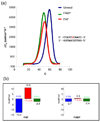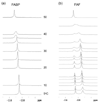Enthalpy-entropy contribution to carcinogen-induced DNA conformational heterogeneity
- PMID: 19961237
- PMCID: PMC2805757
- DOI: 10.1021/bi901629p
Enthalpy-entropy contribution to carcinogen-induced DNA conformational heterogeneity
Abstract
DNA damage by adduct formation is a critical step for the initiation of carcinogenesis. Aromatic amines are strong inducers of environmental carcinogenesis. Their DNA adducts are known to exist in an equilibrium between the major groove (B) and base-displaced stacked (S) conformations. However, the factors governing such heterogeneity remain unclear. Here we conducted extensive calorimetry/NMR/CD studies on the model DNA lesions caused by fluorinated 2-aminfluorene (FAF) and 4-aminobiphenyl (FABP) in order to gain thermodynamic and kinetic insights into the S/B conformational equilibrium. We demonstrate that there are large differences in enthalpy-entropy compensations for FABP and FAF. The small and flexible FABP exclusively adopts the less perturbed B conformer with small enthalpy (DeltaDeltaH-2.7 kcal/mol)/entropy (DeltaDeltaS-0.7 eu) change. In contrast, FAF stacks better and exists as a mixture of B and S conformers with large enthalpy (DeltaDeltaH-13.4 kcal/mol)/entropy (DeltaDeltaS-34.2 eu) compensation. van't Hoff analysis of dynamic (19)F NMR data indicated DeltaH(B<-->S) = 4.1 kcal/mol in favor of the B conformer and DeltaS(B<-->S) = 15.6 cal mol(-1) K(-1) in favor of the intercalated S conformer. These findings demonstrate that the favorable entropy of the S conformer over B conformer determines the S/B population ratios at physiological temperatures.
Figures





Similar articles
-
Thermodynamic, spectroscopic, and equilibrium binding studies of DNA sequence context effects in four 40 base pair deoxyoligonucleotides.Biochemistry. 2000 Jul 4;39(26):7835-46. doi: 10.1021/bi000326k. Biochemistry. 2000. PMID: 10869190
-
The contribution of DNA single-stranded order to the thermodynamics of duplex formation.Proc Natl Acad Sci U S A. 1991 May 1;88(9):3569-73. doi: 10.1073/pnas.88.9.3569. Proc Natl Acad Sci U S A. 1991. PMID: 2023903 Free PMC article.
-
Determination of base and backbone contributions to the thermodynamics of premelting and melting transitions in B DNA.Nucleic Acids Res. 2002 Sep 1;30(17):3767-77. doi: 10.1093/nar/gkf471. Nucleic Acids Res. 2002. PMID: 12202762 Free PMC article.
-
Examination of the long-range effects of aminofluorene-induced conformational heterogeneity and its relevance to the mechanism of translesional DNA synthesis.J Mol Biol. 2007 Mar 9;366(5):1387-400. doi: 10.1016/j.jmb.2006.12.023. Epub 2006 Dec 15. J Mol Biol. 2007. PMID: 17217958 Free PMC article.
-
The Enthalpy-entropy Compensation Phenomenon. Limitations for the Use of Some Basic Thermodynamic Equations.Curr Protein Pept Sci. 2018;19(11):1088-1091. doi: 10.2174/1389203719666180521092615. Curr Protein Pept Sci. 2018. PMID: 29779476 Free PMC article. Review.
Cited by
-
Structure and thermodynamic insights on acetylaminofluorene-modified deletion DNA duplexes as models for frameshift mutagenesis.Chem Res Toxicol. 2013 Jun 17;26(6):937-51. doi: 10.1021/tx400116n. Epub 2013 Jun 4. Chem Res Toxicol. 2013. PMID: 23688347 Free PMC article.
-
Conformational and thermodynamic properties modulate the nucleotide excision repair of 2-aminofluorene and 2-acetylaminofluorene dG adducts in the NarI sequence.Nucleic Acids Res. 2012 May;40(9):3939-51. doi: 10.1093/nar/gkr1307. Epub 2012 Jan 12. Nucleic Acids Res. 2012. PMID: 22241773 Free PMC article.
-
Repair-Resistant DNA Lesions.Chem Res Toxicol. 2017 Aug 21;30(8):1517-1548. doi: 10.1021/acs.chemrestox.7b00128. Epub 2017 Aug 10. Chem Res Toxicol. 2017. PMID: 28750166 Free PMC article. Review.
-
DNA base sequence effects on bulky lesion-induced conformational heterogeneity during DNA replication.Nucleic Acids Res. 2018 Jul 6;46(12):6356-6370. doi: 10.1093/nar/gky409. Nucleic Acids Res. 2018. PMID: 29800374 Free PMC article.
-
Unusual sequence effects on nucleotide excision repair of arylamine lesions: DNA bending/distortion as a primary recognition factor.Nucleic Acids Res. 2013 Jan;41(2):869-80. doi: 10.1093/nar/gks1077. Epub 2012 Nov 23. Nucleic Acids Res. 2013. PMID: 23180767 Free PMC article.
References
-
- Vogelstein B, Kinzler KW. p53 function and dysfunction. Cell. 1992;70:523–526. - PubMed
-
- Menendez D, Linga A, Resnick MA. The expanding universe of p53 targets. Nature Review Cancer. 2009;9:724–737. - PubMed
-
- Greenbaltt MS, Bennett WP, Hollstein MH, Harris CC. Mutations in the p53 tumor suppressor gene: clues to cancer etiology and molecular pathogenesis. Cancer Res. 1994;54:4855–4878. - PubMed
-
- Ljungman M. Targeting the DNA Damage Response in Cancer. Chem. Rev. 2009;109:2929–2950. - PubMed
Publication types
MeSH terms
Substances
Grants and funding
LinkOut - more resources
Full Text Sources

